Monday, April 15, 2019.
I was stuck inside all day studying for one of my finals. After hours of reviewing, I decided I’d finally had enough and I ought to go for a walk to clear my head. I laced up my tennis shoes and headed into the metro without a specific destination in mind. I eventually landed at the Eiffel Tour and decided to walk along the Seine, maybe I’d end up at Place de la Concorde, maybe I’d walk further depending on how I was feeling.
I walked quite a way, just enjoying the sunny spring evening in Paris. The sky was a pristine blue and there was scarcely a cloud in it, except that one… that’s a really odd-looking cloud… no wait, that’s smoke!
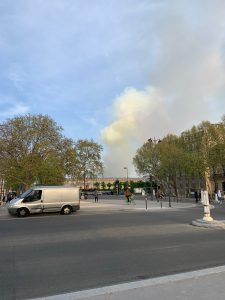
Normally I try to be really casual about weird things that happen in Paris because, well, it’s Paris and plenty of strange things happen here. However, this cloud of smoke caught my attention because it was huge! I followed the smoke which just happened to seem to be the direction of the river, in my head trying to figure out what it could be, an apartment building fire maybe? As I got near, I noticed that the stream of smoke seemed to be growing, something was not right.
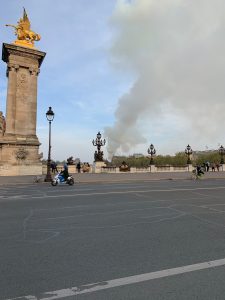
The river curved and so I followed it and I was struck with the oddest view. It looked like the smoke was coming from Ile-de-la-Cité right next to Notre Dame, Paris’ oldest and most well-known church. I kept walking, determined to see what it was, and I saw flames directly on top of the cathedral. If I wasn’t already stressing out and panicking, I was at this point. Notre Dame is on fire?! How could this happen? Notre Dame is made out of stone, how does stone burn? Why is the fire getting bigger?
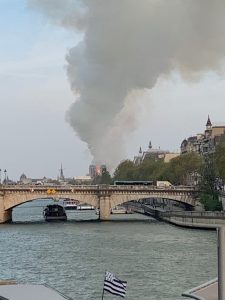
I was in shambles: tears wet my cheeks and my nose ran incessantly. What I felt could only be described as shock. This was a church I walked by at least three times a week and it was now in a complete state of distress. All I could do was stand by and watch as Notre Dame was ravaged by flames. A few minutes passed as I looked at the beautiful cathedral on one of her darkest days. I eventually came to my senses and realized that I didn’t know what caused this. It could have been an act of terrorism and there could have been more planned so I decided it was best that I return home to safety. I was also concerned about the metro as that was my only way home. I wondered if it would be closed as sometimes is the case when there are calamities in the city.
Thankfully, I made it home in one piece with no difficulties. As soon as I opened the door, I blurted out what I’d just witnessed to my host sister, Astrid, who is in her thirties. She was stunned and immediately turned on the radio which was already reporting of the fire raging on the roof of Notre Dame. The rest of the evening I struggled to concentrate on anything other than the fire. I scoured the internet for any kind of information I could find on how it started or if it could be put out. News outlets were predicting that the cause of the fire was in relation to the ongoing renovations happening on the roof, where the fire started, not due to terrorism which relieved me immensely. For a while, I switched between several livestreams to follow the advances of the fire and my heart nearly burst out of my chest as I watched the spire fall. Eventually, I fell asleep, but woke up every couple of hours to check any updates I could find.
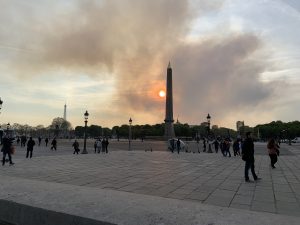
Finally, in the early morning, I saw that Paris firefighters had contained the fire and that the structure of the church was, by and large, saved. I breathed a sigh of relief; Notre Dame wouldn’t be completely destroyed. I proceeded with my morning routine and checked my phone to find that I had so many messages. I had messages from friends and family checking in to make sure that I was okay and expressing their condolences. I made sure to respond to them all and thank them for their concern.
I spent the morning in a daze and picked up a 20 Minute (free newspaper in the Paris metro) that displayed the title Le Drame de Notre-Dame and a photo of Notre Dame in flames. I couldn’t read it because I had a three hour exam that I had to study for during my commute. Thankfully, the exam wasn’t too terrible, and I then had the rest of the day to process through all that I’d seen. I read the article on Notre Dame on my way to see her for myself.
Once out of the metro, I was bombarded with people. Tourists, Parisians, and journalists alike had flooded any street with a view of the Cathedral, all anxious to catch a glimpse of what remained. I managed to push my way through the waves of people to find a place where I could see her well. I was surprised to see that she didn’t look as desolate and destroyed as I’d thought though, at the same time, she was somber. Notre Dame lost her spire and roof. To the untrained eye she looked a little rough, but not terrible. For those of us who’ve seen her more than a few times, you can tell by looking at her that something is different.
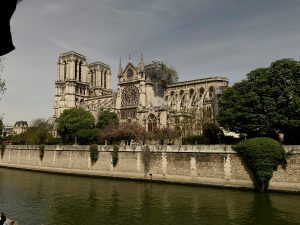
Why does this matter?
Notre Dame is one of the most well-known churches in the world. It actually is the most-visited monument in the city, beating out the Eiffel Tower by nearly twice the number of visitors annually. With Notre Dame now closed to the general public, for at least the foreseeable future, there is going to be a swarm of visitors flocking to other various tourist locations around Paris so it will have a huge impact on crowds. Although, I’m certain they’ll make a point to see her from afar.
Also, there is the matter of preservation of history. Construction on the cathedral started in 1163 when the first stone was placed in the presence of the pope Alexander III. It wasn’t finished until nearly two-hundred years later, in 1345! Since then, plenty of updates have been made to Notre Dame including renovations to keep the building updated in the 850 years since its construction. Most recently, a 150-million-euro renovation was being done on the roof and spire as it had experienced some normal wear-and-tear. It was to be expected from a building that has been around since before the middle ages.
However, it isn’t simply a matter of Notre Dame being an incredibly old church that draws in tourists. After the fire, I saw a lot of posts on Instagram and twitter about how Notre Dame stood through two world wars. Yes, that’s true, she did, but that’s only in the last 100 years. But these posts didn’t even mention the fact that she stood through the French Revolution, the Black Plague, and was around long before most of our ancestors left Europe. A lot of people who haven’t really gotten to know France and the culture tend to think of Notre Dame as being merely a really old and really beautiful church. Maybe they think of it as a setting for a famous book or Disney movie, but for those of us who really knew what she meant to France know better than to simply attribute those titles to her. She survived through so much and continued to stand and represent France and the French people. As the literal center of Paris, Notre Dame embodied the heart of Paris and France as a whole, and to see that go up in flames was to see a piece of the identity of France turn to ash.
Whilst scrolling through all of those posts about the incredible loss of Notre Dame, I was bothered by a general lack of reverence and comprehension of the importance of this monument displayed. I would like to point out that when an event like this happens, it is so incredibly important to research and understand what something symbolizes before posting about it or don’t post at all. I don’t believe posting a family vacation photo in front of Notre Dame with a caption explaining how “lucky you were to see her before this accident” is appropriate to memorialize the monument given the weight of this terrible event.
What do the French think?
The French reaction to the fire at Notre Dame is fairly mixed. In my experience, a the people who were most affected were the adults, Catholic, and non-French. When I got back to my apartment, Astrid, whom I introduced earlier, was shocked and watched the news until late in the night to follow the updates at Notre Dame. Katherine was also heartbroken over the fire.
On the other hand, in one of my university classes at Diderot, the professor (a Russian woman) asked what we all thought about the Notre Dame fire. Most of the students (all in their first year at university) didn’t seem to care, yet these were people who’d lived in Paris their whole lives. My professor seemed much more affected, as were many of my friends in my study abroad program. I’ve also been in several Catholic churches since then and have seen signs up asking parishioners to pray for Notre Dame.
Essentially, I believe that the people who were most affected by the fire were those who were capable of understanding the importance of Notre Dame. My university classmates are so accustomed to having an old church on every street corner so I assume they viewed it as any other. The adults with whom I’ve spoken on the subject appear to be far more invested in what will come of this event.
What’s next?
In the 24 hours following the start of the fire, three billionaires donated a total of 600 million euros for the reconstruction of Notre Dame. France’s president, Emmanuel Macron, declared that they would rebuild and later said that it would be done in 5 years’ time. This was actually quite a shocking statement given the immense amount of work that will have to be done in such a small time span so we’ll see whether that statement is followed up with action. Essentially, the entire roof and spire are completely destroyed so it will be rather precarious work given how high the ceilings are. Needless to say, it will be interesting to see what happens next as we continue in this new chapter for Notre Dame.

